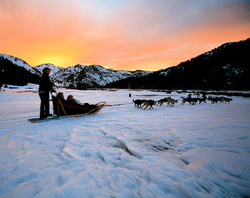
If you thought your commute to work in the winter weather was tough going, spare a thought for the mushers and their dogs who compete in the world's longest dog sledding competition.
Every year, more than 50 teams take place in the Iditarod Trail Sled Dog Race in Alaska, enduring blizzards, whiteouts and temperatures as low as minus 73 degrees Celsius.
Iditarod Trail Dog Sled Race
Every year, more than 50 teams take place in the Iditarod Trail Sled Dog Race in Alaska, enduring blizzards, whiteouts and temperatures as low as minus 73 degrees Celsius.
Iditarod Trail Dog Sled Race
The course covers 1,688 kilometres and winds from Anchorage to Nome, lasting nine to fifteen days. The world's best mushers and their canines travel from all snowy corners of the world to show their dog sledding prowess in the gruelling competition. In Alaskan communities, to be a winner of the Iditarod Trail Dog Sled Race brings celebrity status when warm hugs and mugs of tea, as well as several cold beers, are spread around in celebration.
Last year, 2011, the fastest ever finish was recorded by John Baker with a winning time of eight days, 19 hours and 39 seconds. It's not surprising when he started mushing aged only one! This year saw the youngest person in history to win the race. The 25-year-old Alaskan musher, Dallas Seavey, took first position with a winning time of just over nine days. Born into a family with a great passion for dog sledding, he was brought up with a great respect for the sport - his grandfather was one of the original competitors when it started in the 1970s.
History
Centuries before the arrival of the Europeans, dog sledding was the only means of transportation for the native people Athabaskana and Inupiaq. They used trails that crisscrossed Alaska, some of which make up today's Iditarod Trail.
Between the 1880s and 1920s, when the gold rush reached Nome in Alaska, the trail was being used at its peak, transporting miners and minerals. During winter months, when the normal transportation of steamship became inadequate, those out to seek their fortune turned to the Iditarod Trail, the mushers and their faithful packs of huskies to get them across the hinterland.
The Arrival of the Metal Dog
In the 1960s, snowmobiles overtook dog sledding as the main method of transportation in Alaska and Canada. The machines, often referred to as 'metal dogs', brought the ancient way of sledding to near extinction in rural areas.
The Start of the Race
The race began in 1973 as a way to revive the culture and ensure that it remains a focal point of modern day communities. Initially the race was only 90 kilometres long but, with much persuasion and help from mushers, the race got underway as the 1,688-kilometre trail in 1973.
(source: ezinearticles)
Check out cheapadizerorose.com regarding finest value Adidas Adizero Ghost and also Adidas AdiZero Rose 2.5 nowadays!
Last year, 2011, the fastest ever finish was recorded by John Baker with a winning time of eight days, 19 hours and 39 seconds. It's not surprising when he started mushing aged only one! This year saw the youngest person in history to win the race. The 25-year-old Alaskan musher, Dallas Seavey, took first position with a winning time of just over nine days. Born into a family with a great passion for dog sledding, he was brought up with a great respect for the sport - his grandfather was one of the original competitors when it started in the 1970s.
History
Centuries before the arrival of the Europeans, dog sledding was the only means of transportation for the native people Athabaskana and Inupiaq. They used trails that crisscrossed Alaska, some of which make up today's Iditarod Trail.
Between the 1880s and 1920s, when the gold rush reached Nome in Alaska, the trail was being used at its peak, transporting miners and minerals. During winter months, when the normal transportation of steamship became inadequate, those out to seek their fortune turned to the Iditarod Trail, the mushers and their faithful packs of huskies to get them across the hinterland.
The Arrival of the Metal Dog
In the 1960s, snowmobiles overtook dog sledding as the main method of transportation in Alaska and Canada. The machines, often referred to as 'metal dogs', brought the ancient way of sledding to near extinction in rural areas.
The Start of the Race
The race began in 1973 as a way to revive the culture and ensure that it remains a focal point of modern day communities. Initially the race was only 90 kilometres long but, with much persuasion and help from mushers, the race got underway as the 1,688-kilometre trail in 1973.
(source: ezinearticles)
Check out cheapadizerorose.com regarding finest value Adidas Adizero Ghost and also Adidas AdiZero Rose 2.5 nowadays!



 RSS Feed
RSS Feed